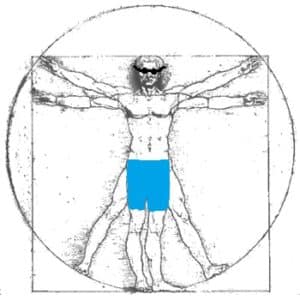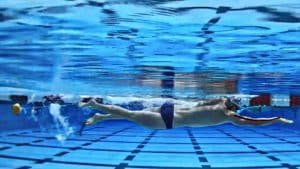Stroke Length – How Long Is Too Long

For many years people have strived for a longer stroke length through the water. In many endurance sports, a key focus is a longer distance for each stroke or stride. But at what point does stroke length become TOO long?
The answer really is “IT DEPENDS“.
This comes down to reach/arm span, shoulder control/flexibility, strength, and your kinaesthetic or body awareness.
What Is Stroke Length
Stroke length is the distance that you travel for each arm “pull” on the water. Because of water’s density, your upper limit of stroke length is your arm span.

The Vitruvian Swimmer
In reality, though, most people don’t have the control of the water or the strength to get near this.
What most end up doing is reaching as far forward as they can – to maximise the length that the arm can pull through. This can have more of a negative effect than a positive, as it results in less efficient or less useful body positions.
As you can see in the image above, at the point where the swimmer is at his longest – ie with the arm stretched forward – his elbow is below his hand. This is going to make it very difficult to do anything more with his pull than drag his elbow backwards, not making the use of his forearms as a paddle, or being able to use so much of the larger muscles in his back. It will also likely cause him to stall at the front and make life harder to keep that constant motion of his stroke – so slowing him down.
What To Do
When you overreach, you have less control over your arm, and that point will come at different stages depending on how flexible you are through your shoulders.
Try this: stand up straight and lift your arm above your head. It should feel reasonably comfortable (hopefully!). Now if you reach up as high as you can, see where the rest of your body ends up. For most people shoulders end up around ears and the body starts to arch to one side. From this, when you are swimming focus on reaching forward (without stretching) from your hips rather than your shoulder – it should help maintain that core control, keep your stroke straighter and prevent your elbow from dropping down. It may help also to aim for a point 3-4 inches below the surface to make sure that your hand is always slightly below your elbow.
If you’re swimming drills, try catch up. With both arms out in front, you can make sure that they are level and below the surface. You could do 6 kicks to 1 pull (6-1-6) to practise maintaining a straight line from hip to hand. Or you could do an entry point scull – again with a focus on relaxed shoulders. Whatever drill you do, make sure that it feels comfortable; it’s about finding the position that works for you.
If you have any questions or comments, please feel free to get in touch; either by email, facebook or leave a comment on here! Remember, you can always get your swimming reviewed in the endless pool with our video swim analysis packages.
See what’s up next week for our #SwimTechTues tip!

